UMODPX-15-M: Critical Reflection on Global Team Leadership
VerifiedAdded on 2022/08/30
|8
|2252
|12
Report
AI Summary
This report presents an executive summary analyzing the author's personal experience within a global organization, focusing on leadership practices and their impact. The report critically reflects on the team leader's performance, highlighting shortcomings in team management, diversity handling, and conflict resolution. Key themes explored include leadership styles, diversity within a multicultural team, and the effectiveness of teamwork. The analysis delves into the leader's failure to promote a positive workspace, manage cultural nuances, and address workplace conflicts promptly, leading to disruptions in workflow and team dynamics. The report provides recommendations for improving leadership effectiveness, emphasizing the importance of skilled leadership, clear role definitions, and timely issue resolution. The findings underscore the significance of effective leadership in fostering a productive and harmonious global work environment.
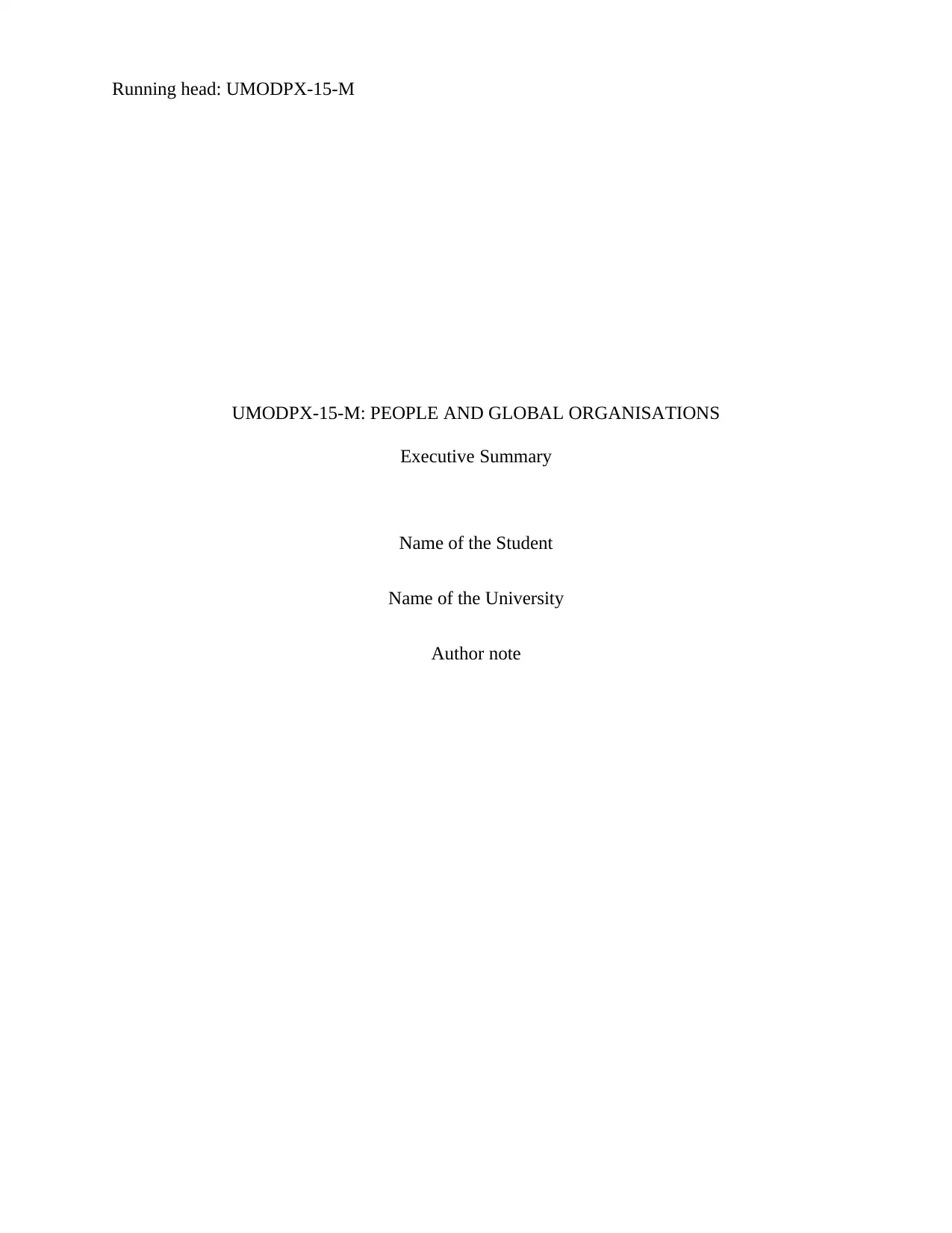
Running head: UMODPX-15-M
UMODPX-15-M: PEOPLE AND GLOBAL ORGANISATIONS
Executive Summary
Name of the Student
Name of the University
Author note
UMODPX-15-M: PEOPLE AND GLOBAL ORGANISATIONS
Executive Summary
Name of the Student
Name of the University
Author note
Paraphrase This Document
Need a fresh take? Get an instant paraphrase of this document with our AI Paraphraser
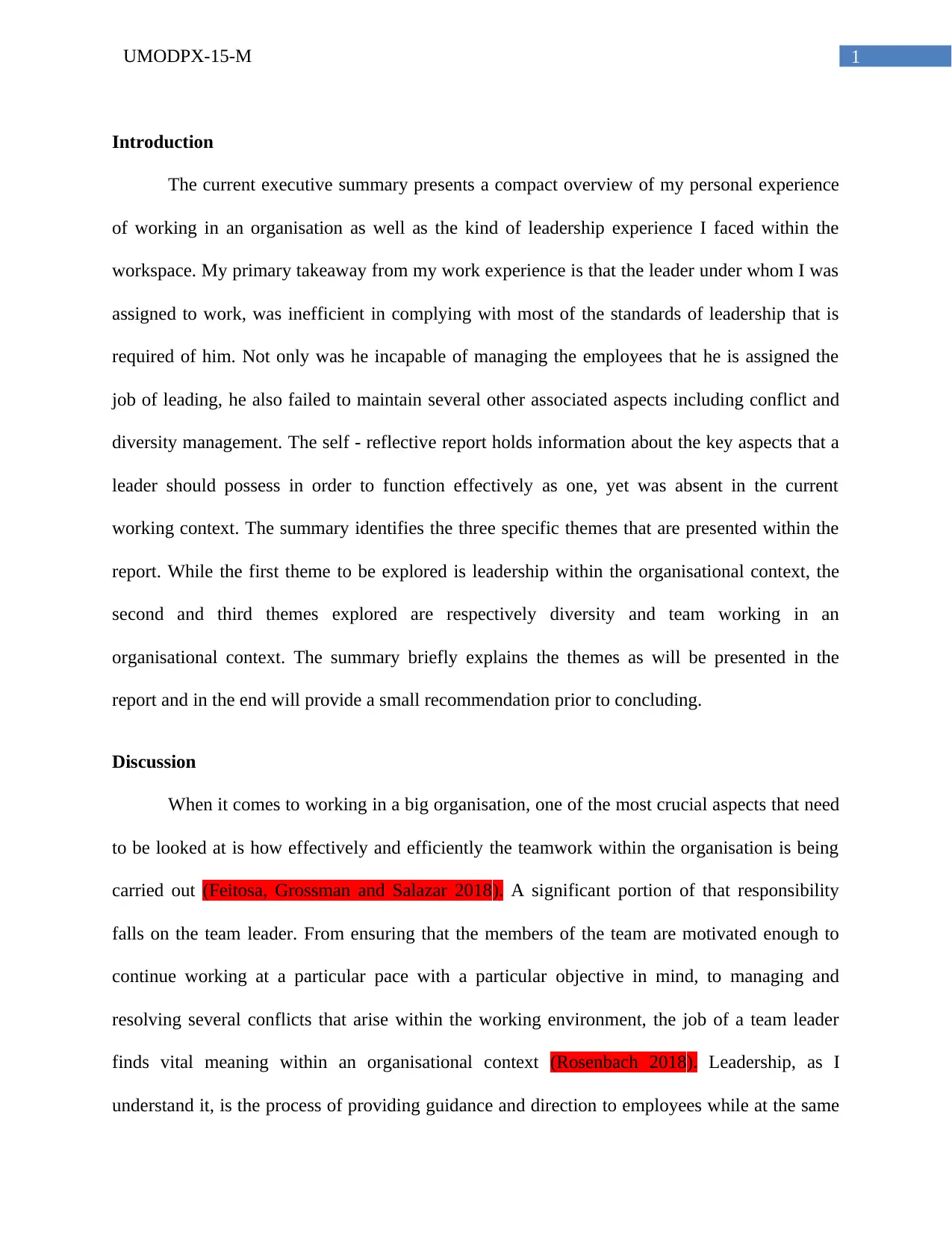
1UMODPX-15-M
Introduction
The current executive summary presents a compact overview of my personal experience
of working in an organisation as well as the kind of leadership experience I faced within the
workspace. My primary takeaway from my work experience is that the leader under whom I was
assigned to work, was inefficient in complying with most of the standards of leadership that is
required of him. Not only was he incapable of managing the employees that he is assigned the
job of leading, he also failed to maintain several other associated aspects including conflict and
diversity management. The self - reflective report holds information about the key aspects that a
leader should possess in order to function effectively as one, yet was absent in the current
working context. The summary identifies the three specific themes that are presented within the
report. While the first theme to be explored is leadership within the organisational context, the
second and third themes explored are respectively diversity and team working in an
organisational context. The summary briefly explains the themes as will be presented in the
report and in the end will provide a small recommendation prior to concluding.
Discussion
When it comes to working in a big organisation, one of the most crucial aspects that need
to be looked at is how effectively and efficiently the teamwork within the organisation is being
carried out (Feitosa, Grossman and Salazar 2018). A significant portion of that responsibility
falls on the team leader. From ensuring that the members of the team are motivated enough to
continue working at a particular pace with a particular objective in mind, to managing and
resolving several conflicts that arise within the working environment, the job of a team leader
finds vital meaning within an organisational context (Rosenbach 2018). Leadership, as I
understand it, is the process of providing guidance and direction to employees while at the same
Introduction
The current executive summary presents a compact overview of my personal experience
of working in an organisation as well as the kind of leadership experience I faced within the
workspace. My primary takeaway from my work experience is that the leader under whom I was
assigned to work, was inefficient in complying with most of the standards of leadership that is
required of him. Not only was he incapable of managing the employees that he is assigned the
job of leading, he also failed to maintain several other associated aspects including conflict and
diversity management. The self - reflective report holds information about the key aspects that a
leader should possess in order to function effectively as one, yet was absent in the current
working context. The summary identifies the three specific themes that are presented within the
report. While the first theme to be explored is leadership within the organisational context, the
second and third themes explored are respectively diversity and team working in an
organisational context. The summary briefly explains the themes as will be presented in the
report and in the end will provide a small recommendation prior to concluding.
Discussion
When it comes to working in a big organisation, one of the most crucial aspects that need
to be looked at is how effectively and efficiently the teamwork within the organisation is being
carried out (Feitosa, Grossman and Salazar 2018). A significant portion of that responsibility
falls on the team leader. From ensuring that the members of the team are motivated enough to
continue working at a particular pace with a particular objective in mind, to managing and
resolving several conflicts that arise within the working environment, the job of a team leader
finds vital meaning within an organisational context (Rosenbach 2018). Leadership, as I
understand it, is the process of providing guidance and direction to employees while at the same
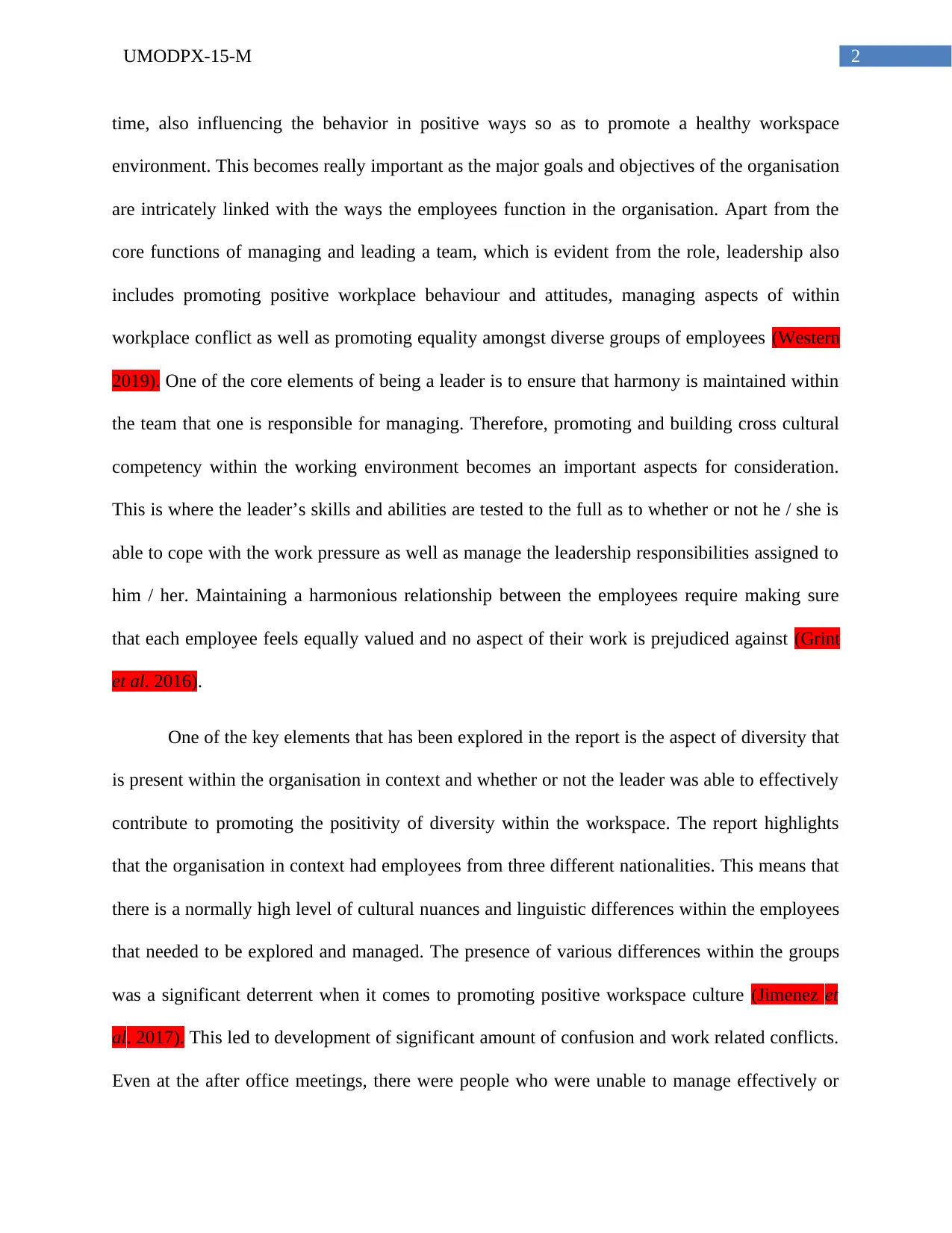
2UMODPX-15-M
time, also influencing the behavior in positive ways so as to promote a healthy workspace
environment. This becomes really important as the major goals and objectives of the organisation
are intricately linked with the ways the employees function in the organisation. Apart from the
core functions of managing and leading a team, which is evident from the role, leadership also
includes promoting positive workplace behaviour and attitudes, managing aspects of within
workplace conflict as well as promoting equality amongst diverse groups of employees (Western
2019). One of the core elements of being a leader is to ensure that harmony is maintained within
the team that one is responsible for managing. Therefore, promoting and building cross cultural
competency within the working environment becomes an important aspects for consideration.
This is where the leader’s skills and abilities are tested to the full as to whether or not he / she is
able to cope with the work pressure as well as manage the leadership responsibilities assigned to
him / her. Maintaining a harmonious relationship between the employees require making sure
that each employee feels equally valued and no aspect of their work is prejudiced against (Grint
et al. 2016).
One of the key elements that has been explored in the report is the aspect of diversity that
is present within the organisation in context and whether or not the leader was able to effectively
contribute to promoting the positivity of diversity within the workspace. The report highlights
that the organisation in context had employees from three different nationalities. This means that
there is a normally high level of cultural nuances and linguistic differences within the employees
that needed to be explored and managed. The presence of various differences within the groups
was a significant deterrent when it comes to promoting positive workspace culture (Jimenez et
al. 2017). This led to development of significant amount of confusion and work related conflicts.
Even at the after office meetings, there were people who were unable to manage effectively or
time, also influencing the behavior in positive ways so as to promote a healthy workspace
environment. This becomes really important as the major goals and objectives of the organisation
are intricately linked with the ways the employees function in the organisation. Apart from the
core functions of managing and leading a team, which is evident from the role, leadership also
includes promoting positive workplace behaviour and attitudes, managing aspects of within
workplace conflict as well as promoting equality amongst diverse groups of employees (Western
2019). One of the core elements of being a leader is to ensure that harmony is maintained within
the team that one is responsible for managing. Therefore, promoting and building cross cultural
competency within the working environment becomes an important aspects for consideration.
This is where the leader’s skills and abilities are tested to the full as to whether or not he / she is
able to cope with the work pressure as well as manage the leadership responsibilities assigned to
him / her. Maintaining a harmonious relationship between the employees require making sure
that each employee feels equally valued and no aspect of their work is prejudiced against (Grint
et al. 2016).
One of the key elements that has been explored in the report is the aspect of diversity that
is present within the organisation in context and whether or not the leader was able to effectively
contribute to promoting the positivity of diversity within the workspace. The report highlights
that the organisation in context had employees from three different nationalities. This means that
there is a normally high level of cultural nuances and linguistic differences within the employees
that needed to be explored and managed. The presence of various differences within the groups
was a significant deterrent when it comes to promoting positive workspace culture (Jimenez et
al. 2017). This led to development of significant amount of confusion and work related conflicts.
Even at the after office meetings, there were people who were unable to manage effectively or
⊘ This is a preview!⊘
Do you want full access?
Subscribe today to unlock all pages.

Trusted by 1+ million students worldwide
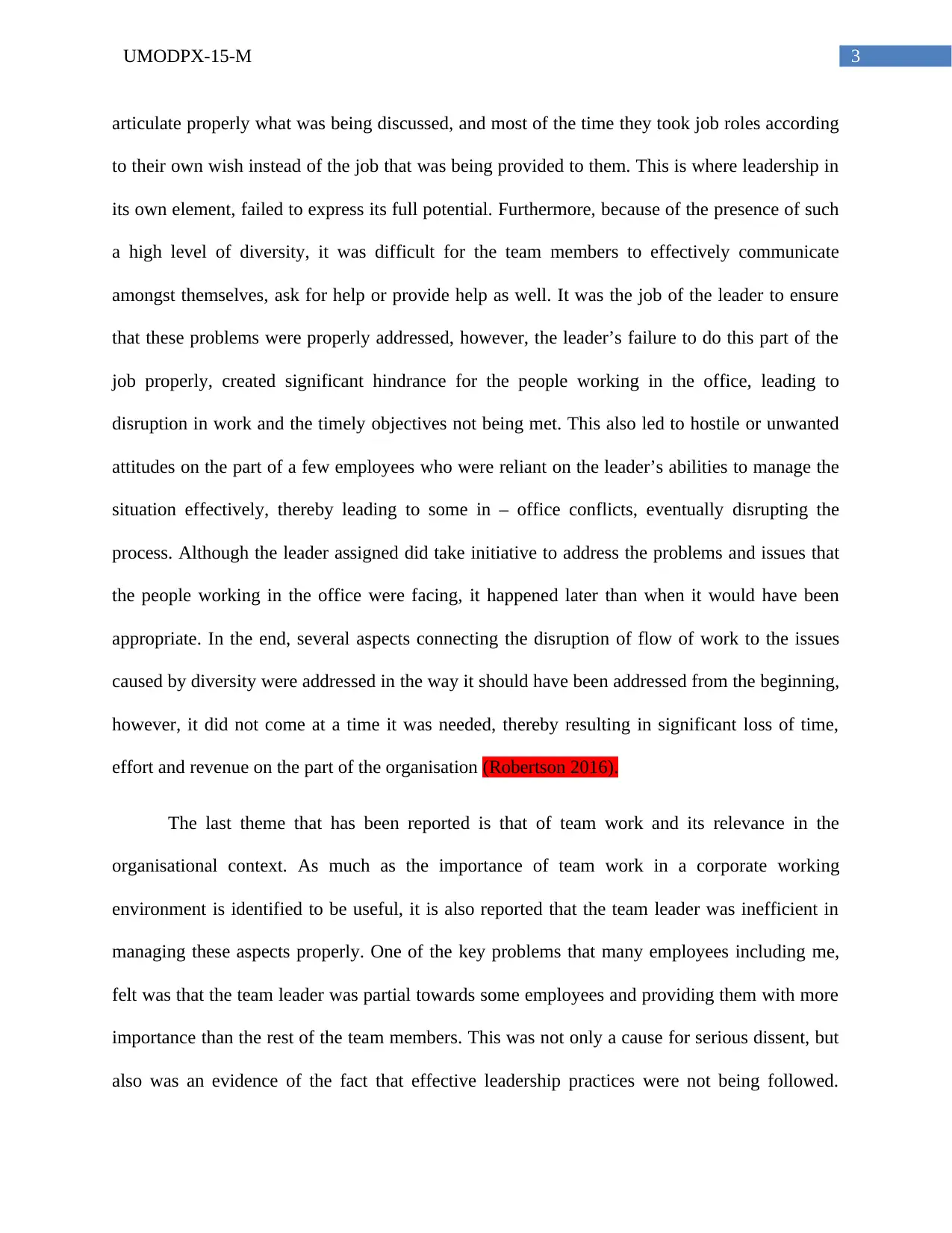
3UMODPX-15-M
articulate properly what was being discussed, and most of the time they took job roles according
to their own wish instead of the job that was being provided to them. This is where leadership in
its own element, failed to express its full potential. Furthermore, because of the presence of such
a high level of diversity, it was difficult for the team members to effectively communicate
amongst themselves, ask for help or provide help as well. It was the job of the leader to ensure
that these problems were properly addressed, however, the leader’s failure to do this part of the
job properly, created significant hindrance for the people working in the office, leading to
disruption in work and the timely objectives not being met. This also led to hostile or unwanted
attitudes on the part of a few employees who were reliant on the leader’s abilities to manage the
situation effectively, thereby leading to some in – office conflicts, eventually disrupting the
process. Although the leader assigned did take initiative to address the problems and issues that
the people working in the office were facing, it happened later than when it would have been
appropriate. In the end, several aspects connecting the disruption of flow of work to the issues
caused by diversity were addressed in the way it should have been addressed from the beginning,
however, it did not come at a time it was needed, thereby resulting in significant loss of time,
effort and revenue on the part of the organisation (Robertson 2016).
The last theme that has been reported is that of team work and its relevance in the
organisational context. As much as the importance of team work in a corporate working
environment is identified to be useful, it is also reported that the team leader was inefficient in
managing these aspects properly. One of the key problems that many employees including me,
felt was that the team leader was partial towards some employees and providing them with more
importance than the rest of the team members. This was not only a cause for serious dissent, but
also was an evidence of the fact that effective leadership practices were not being followed.
articulate properly what was being discussed, and most of the time they took job roles according
to their own wish instead of the job that was being provided to them. This is where leadership in
its own element, failed to express its full potential. Furthermore, because of the presence of such
a high level of diversity, it was difficult for the team members to effectively communicate
amongst themselves, ask for help or provide help as well. It was the job of the leader to ensure
that these problems were properly addressed, however, the leader’s failure to do this part of the
job properly, created significant hindrance for the people working in the office, leading to
disruption in work and the timely objectives not being met. This also led to hostile or unwanted
attitudes on the part of a few employees who were reliant on the leader’s abilities to manage the
situation effectively, thereby leading to some in – office conflicts, eventually disrupting the
process. Although the leader assigned did take initiative to address the problems and issues that
the people working in the office were facing, it happened later than when it would have been
appropriate. In the end, several aspects connecting the disruption of flow of work to the issues
caused by diversity were addressed in the way it should have been addressed from the beginning,
however, it did not come at a time it was needed, thereby resulting in significant loss of time,
effort and revenue on the part of the organisation (Robertson 2016).
The last theme that has been reported is that of team work and its relevance in the
organisational context. As much as the importance of team work in a corporate working
environment is identified to be useful, it is also reported that the team leader was inefficient in
managing these aspects properly. One of the key problems that many employees including me,
felt was that the team leader was partial towards some employees and providing them with more
importance than the rest of the team members. This was not only a cause for serious dissent, but
also was an evidence of the fact that effective leadership practices were not being followed.
Paraphrase This Document
Need a fresh take? Get an instant paraphrase of this document with our AI Paraphraser
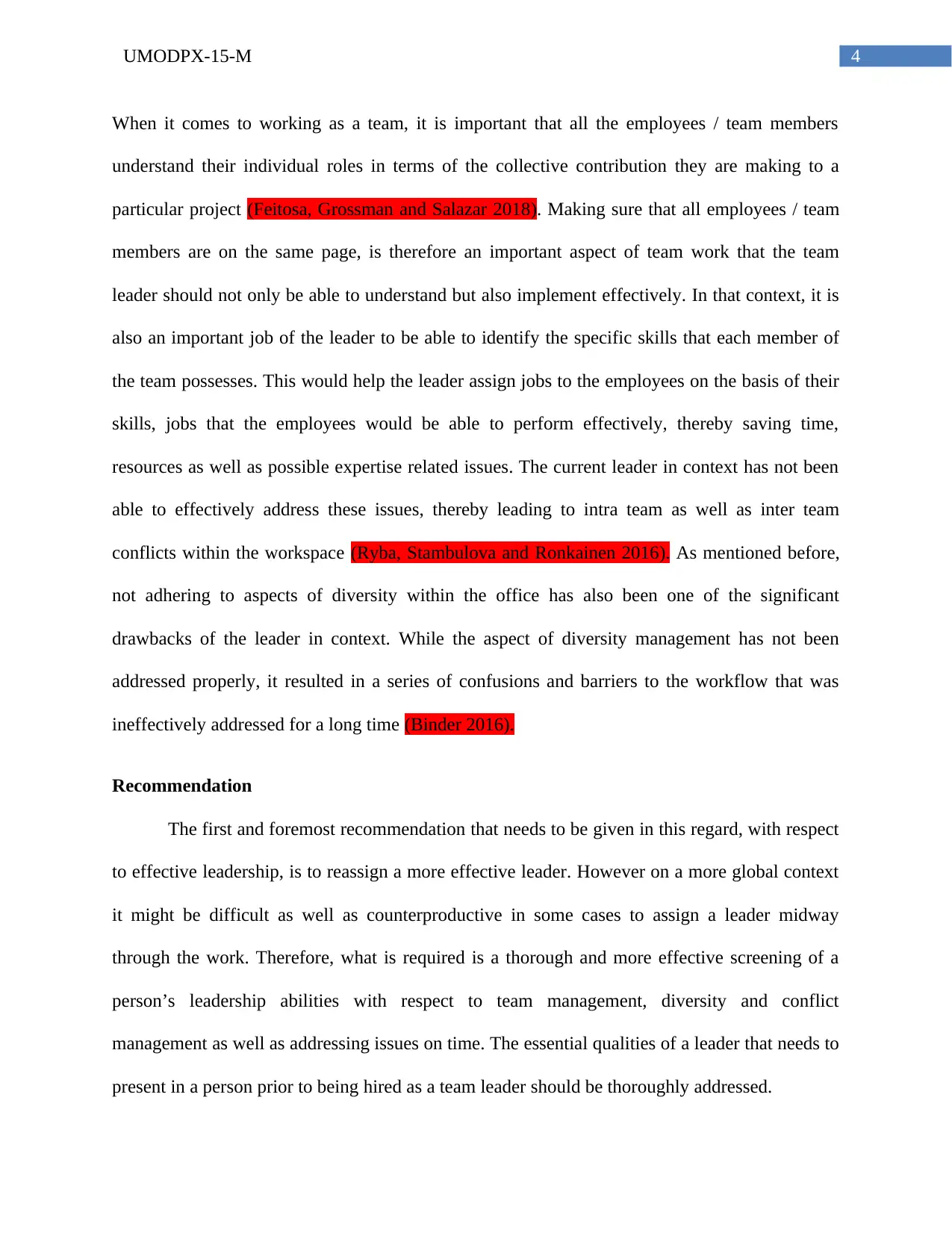
4UMODPX-15-M
When it comes to working as a team, it is important that all the employees / team members
understand their individual roles in terms of the collective contribution they are making to a
particular project (Feitosa, Grossman and Salazar 2018). Making sure that all employees / team
members are on the same page, is therefore an important aspect of team work that the team
leader should not only be able to understand but also implement effectively. In that context, it is
also an important job of the leader to be able to identify the specific skills that each member of
the team possesses. This would help the leader assign jobs to the employees on the basis of their
skills, jobs that the employees would be able to perform effectively, thereby saving time,
resources as well as possible expertise related issues. The current leader in context has not been
able to effectively address these issues, thereby leading to intra team as well as inter team
conflicts within the workspace (Ryba, Stambulova and Ronkainen 2016). As mentioned before,
not adhering to aspects of diversity within the office has also been one of the significant
drawbacks of the leader in context. While the aspect of diversity management has not been
addressed properly, it resulted in a series of confusions and barriers to the workflow that was
ineffectively addressed for a long time (Binder 2016).
Recommendation
The first and foremost recommendation that needs to be given in this regard, with respect
to effective leadership, is to reassign a more effective leader. However on a more global context
it might be difficult as well as counterproductive in some cases to assign a leader midway
through the work. Therefore, what is required is a thorough and more effective screening of a
person’s leadership abilities with respect to team management, diversity and conflict
management as well as addressing issues on time. The essential qualities of a leader that needs to
present in a person prior to being hired as a team leader should be thoroughly addressed.
When it comes to working as a team, it is important that all the employees / team members
understand their individual roles in terms of the collective contribution they are making to a
particular project (Feitosa, Grossman and Salazar 2018). Making sure that all employees / team
members are on the same page, is therefore an important aspect of team work that the team
leader should not only be able to understand but also implement effectively. In that context, it is
also an important job of the leader to be able to identify the specific skills that each member of
the team possesses. This would help the leader assign jobs to the employees on the basis of their
skills, jobs that the employees would be able to perform effectively, thereby saving time,
resources as well as possible expertise related issues. The current leader in context has not been
able to effectively address these issues, thereby leading to intra team as well as inter team
conflicts within the workspace (Ryba, Stambulova and Ronkainen 2016). As mentioned before,
not adhering to aspects of diversity within the office has also been one of the significant
drawbacks of the leader in context. While the aspect of diversity management has not been
addressed properly, it resulted in a series of confusions and barriers to the workflow that was
ineffectively addressed for a long time (Binder 2016).
Recommendation
The first and foremost recommendation that needs to be given in this regard, with respect
to effective leadership, is to reassign a more effective leader. However on a more global context
it might be difficult as well as counterproductive in some cases to assign a leader midway
through the work. Therefore, what is required is a thorough and more effective screening of a
person’s leadership abilities with respect to team management, diversity and conflict
management as well as addressing issues on time. The essential qualities of a leader that needs to
present in a person prior to being hired as a team leader should be thoroughly addressed.
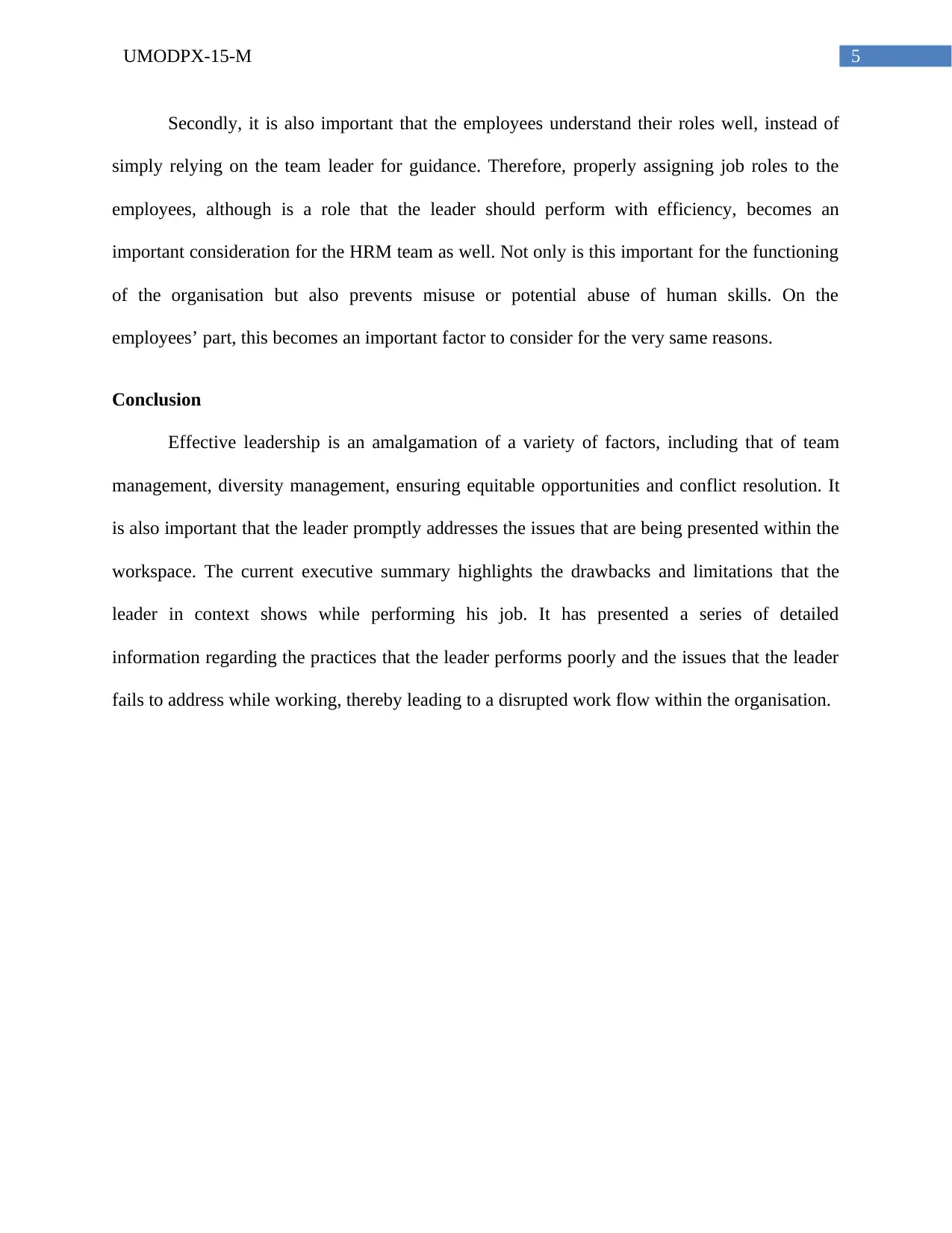
5UMODPX-15-M
Secondly, it is also important that the employees understand their roles well, instead of
simply relying on the team leader for guidance. Therefore, properly assigning job roles to the
employees, although is a role that the leader should perform with efficiency, becomes an
important consideration for the HRM team as well. Not only is this important for the functioning
of the organisation but also prevents misuse or potential abuse of human skills. On the
employees’ part, this becomes an important factor to consider for the very same reasons.
Conclusion
Effective leadership is an amalgamation of a variety of factors, including that of team
management, diversity management, ensuring equitable opportunities and conflict resolution. It
is also important that the leader promptly addresses the issues that are being presented within the
workspace. The current executive summary highlights the drawbacks and limitations that the
leader in context shows while performing his job. It has presented a series of detailed
information regarding the practices that the leader performs poorly and the issues that the leader
fails to address while working, thereby leading to a disrupted work flow within the organisation.
Secondly, it is also important that the employees understand their roles well, instead of
simply relying on the team leader for guidance. Therefore, properly assigning job roles to the
employees, although is a role that the leader should perform with efficiency, becomes an
important consideration for the HRM team as well. Not only is this important for the functioning
of the organisation but also prevents misuse or potential abuse of human skills. On the
employees’ part, this becomes an important factor to consider for the very same reasons.
Conclusion
Effective leadership is an amalgamation of a variety of factors, including that of team
management, diversity management, ensuring equitable opportunities and conflict resolution. It
is also important that the leader promptly addresses the issues that are being presented within the
workspace. The current executive summary highlights the drawbacks and limitations that the
leader in context shows while performing his job. It has presented a series of detailed
information regarding the practices that the leader performs poorly and the issues that the leader
fails to address while working, thereby leading to a disrupted work flow within the organisation.
⊘ This is a preview!⊘
Do you want full access?
Subscribe today to unlock all pages.

Trusted by 1+ million students worldwide
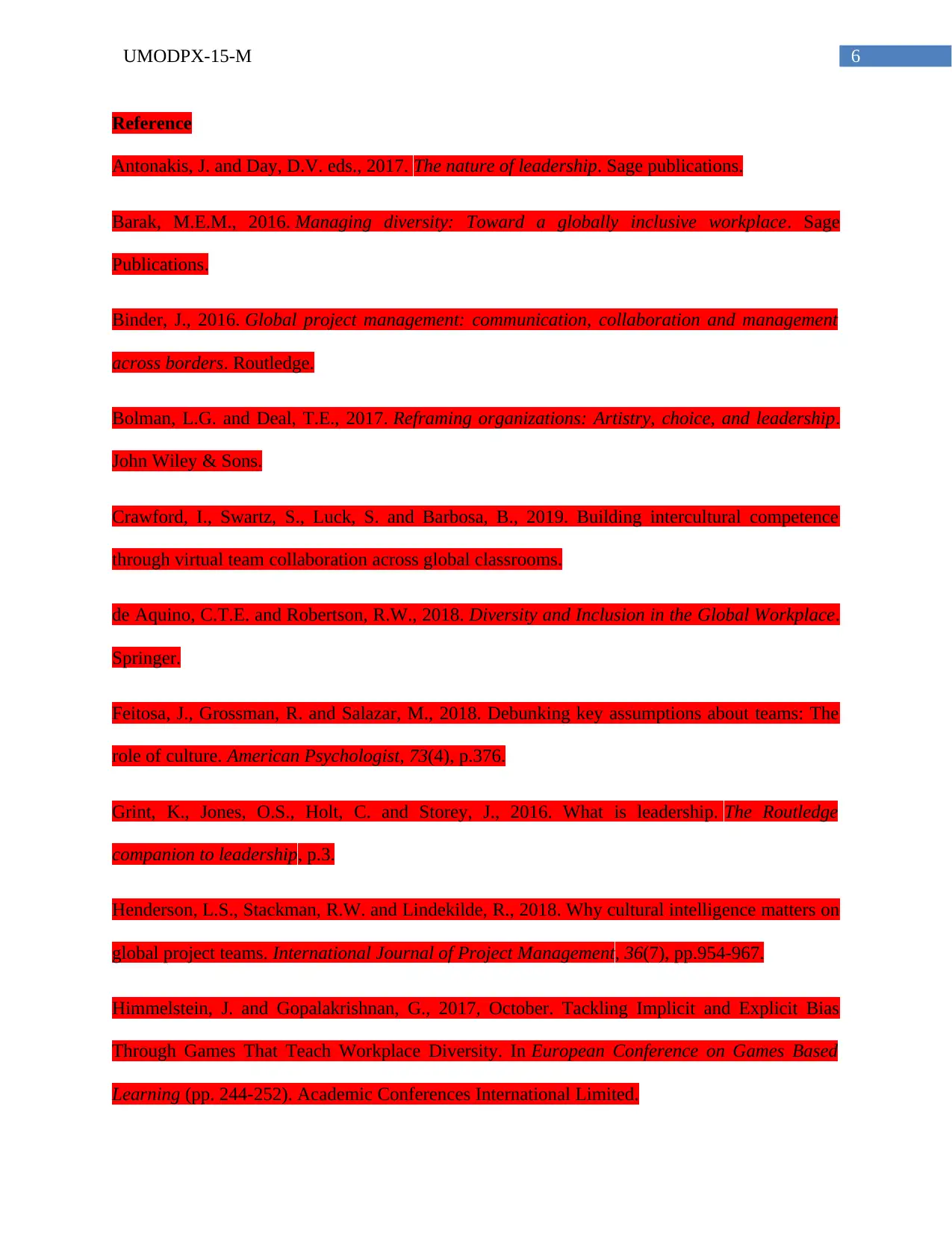
6UMODPX-15-M
Reference
Antonakis, J. and Day, D.V. eds., 2017. The nature of leadership. Sage publications.
Barak, M.E.M., 2016. Managing diversity: Toward a globally inclusive workplace. Sage
Publications.
Binder, J., 2016. Global project management: communication, collaboration and management
across borders. Routledge.
Bolman, L.G. and Deal, T.E., 2017. Reframing organizations: Artistry, choice, and leadership.
John Wiley & Sons.
Crawford, I., Swartz, S., Luck, S. and Barbosa, B., 2019. Building intercultural competence
through virtual team collaboration across global classrooms.
de Aquino, C.T.E. and Robertson, R.W., 2018. Diversity and Inclusion in the Global Workplace.
Springer.
Feitosa, J., Grossman, R. and Salazar, M., 2018. Debunking key assumptions about teams: The
role of culture. American Psychologist, 73(4), p.376.
Grint, K., Jones, O.S., Holt, C. and Storey, J., 2016. What is leadership. The Routledge
companion to leadership, p.3.
Henderson, L.S., Stackman, R.W. and Lindekilde, R., 2018. Why cultural intelligence matters on
global project teams. International Journal of Project Management, 36(7), pp.954-967.
Himmelstein, J. and Gopalakrishnan, G., 2017, October. Tackling Implicit and Explicit Bias
Through Games That Teach Workplace Diversity. In European Conference on Games Based
Learning (pp. 244-252). Academic Conferences International Limited.
Reference
Antonakis, J. and Day, D.V. eds., 2017. The nature of leadership. Sage publications.
Barak, M.E.M., 2016. Managing diversity: Toward a globally inclusive workplace. Sage
Publications.
Binder, J., 2016. Global project management: communication, collaboration and management
across borders. Routledge.
Bolman, L.G. and Deal, T.E., 2017. Reframing organizations: Artistry, choice, and leadership.
John Wiley & Sons.
Crawford, I., Swartz, S., Luck, S. and Barbosa, B., 2019. Building intercultural competence
through virtual team collaboration across global classrooms.
de Aquino, C.T.E. and Robertson, R.W., 2018. Diversity and Inclusion in the Global Workplace.
Springer.
Feitosa, J., Grossman, R. and Salazar, M., 2018. Debunking key assumptions about teams: The
role of culture. American Psychologist, 73(4), p.376.
Grint, K., Jones, O.S., Holt, C. and Storey, J., 2016. What is leadership. The Routledge
companion to leadership, p.3.
Henderson, L.S., Stackman, R.W. and Lindekilde, R., 2018. Why cultural intelligence matters on
global project teams. International Journal of Project Management, 36(7), pp.954-967.
Himmelstein, J. and Gopalakrishnan, G., 2017, October. Tackling Implicit and Explicit Bias
Through Games That Teach Workplace Diversity. In European Conference on Games Based
Learning (pp. 244-252). Academic Conferences International Limited.
Paraphrase This Document
Need a fresh take? Get an instant paraphrase of this document with our AI Paraphraser
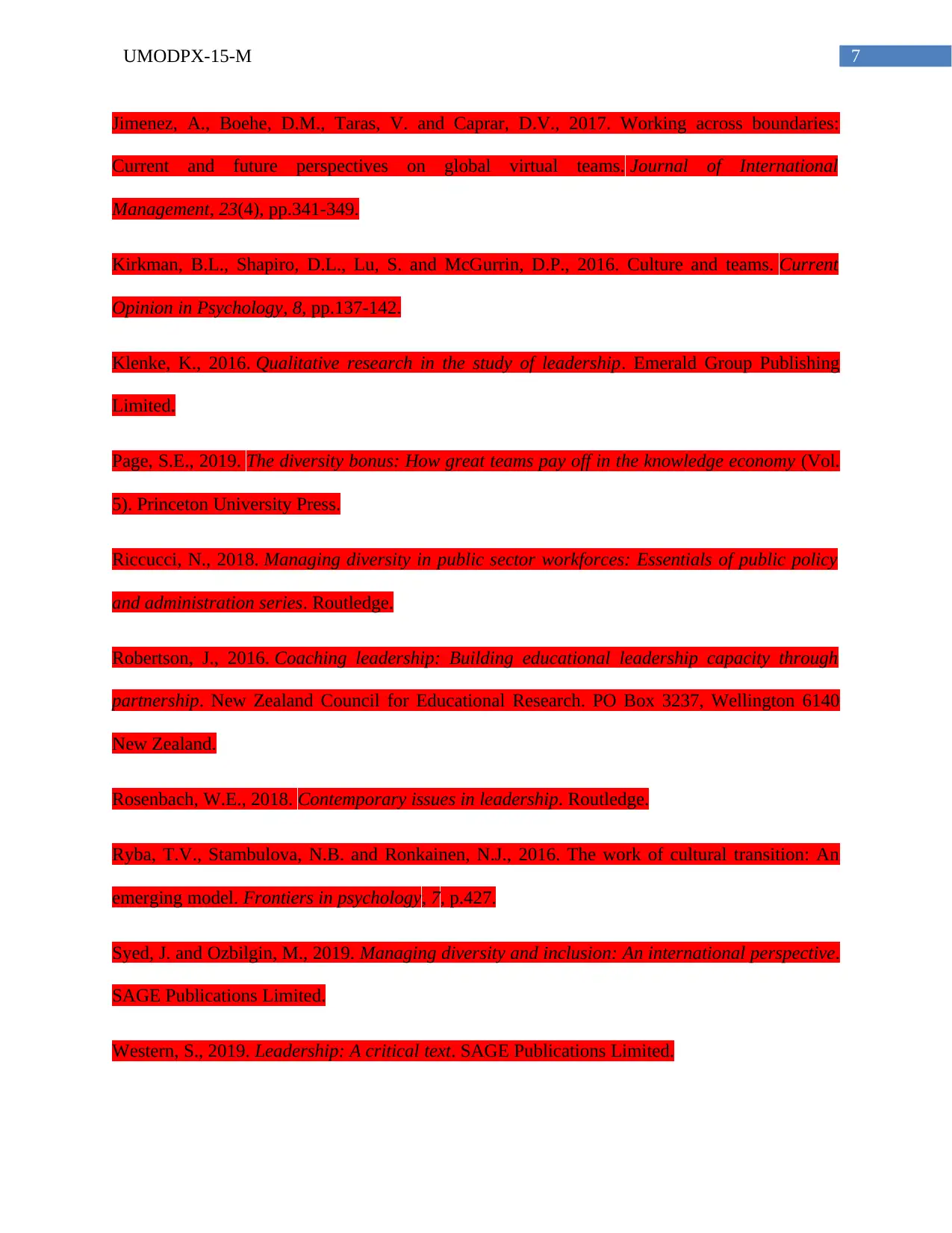
7UMODPX-15-M
Jimenez, A., Boehe, D.M., Taras, V. and Caprar, D.V., 2017. Working across boundaries:
Current and future perspectives on global virtual teams. Journal of International
Management, 23(4), pp.341-349.
Kirkman, B.L., Shapiro, D.L., Lu, S. and McGurrin, D.P., 2016. Culture and teams. Current
Opinion in Psychology, 8, pp.137-142.
Klenke, K., 2016. Qualitative research in the study of leadership. Emerald Group Publishing
Limited.
Page, S.E., 2019. The diversity bonus: How great teams pay off in the knowledge economy (Vol.
5). Princeton University Press.
Riccucci, N., 2018. Managing diversity in public sector workforces: Essentials of public policy
and administration series. Routledge.
Robertson, J., 2016. Coaching leadership: Building educational leadership capacity through
partnership. New Zealand Council for Educational Research. PO Box 3237, Wellington 6140
New Zealand.
Rosenbach, W.E., 2018. Contemporary issues in leadership. Routledge.
Ryba, T.V., Stambulova, N.B. and Ronkainen, N.J., 2016. The work of cultural transition: An
emerging model. Frontiers in psychology, 7, p.427.
Syed, J. and Ozbilgin, M., 2019. Managing diversity and inclusion: An international perspective.
SAGE Publications Limited.
Western, S., 2019. Leadership: A critical text. SAGE Publications Limited.
Jimenez, A., Boehe, D.M., Taras, V. and Caprar, D.V., 2017. Working across boundaries:
Current and future perspectives on global virtual teams. Journal of International
Management, 23(4), pp.341-349.
Kirkman, B.L., Shapiro, D.L., Lu, S. and McGurrin, D.P., 2016. Culture and teams. Current
Opinion in Psychology, 8, pp.137-142.
Klenke, K., 2016. Qualitative research in the study of leadership. Emerald Group Publishing
Limited.
Page, S.E., 2019. The diversity bonus: How great teams pay off in the knowledge economy (Vol.
5). Princeton University Press.
Riccucci, N., 2018. Managing diversity in public sector workforces: Essentials of public policy
and administration series. Routledge.
Robertson, J., 2016. Coaching leadership: Building educational leadership capacity through
partnership. New Zealand Council for Educational Research. PO Box 3237, Wellington 6140
New Zealand.
Rosenbach, W.E., 2018. Contemporary issues in leadership. Routledge.
Ryba, T.V., Stambulova, N.B. and Ronkainen, N.J., 2016. The work of cultural transition: An
emerging model. Frontiers in psychology, 7, p.427.
Syed, J. and Ozbilgin, M., 2019. Managing diversity and inclusion: An international perspective.
SAGE Publications Limited.
Western, S., 2019. Leadership: A critical text. SAGE Publications Limited.
1 out of 8
Related Documents
Your All-in-One AI-Powered Toolkit for Academic Success.
+13062052269
info@desklib.com
Available 24*7 on WhatsApp / Email
![[object Object]](/_next/static/media/star-bottom.7253800d.svg)
Unlock your academic potential
Copyright © 2020–2025 A2Z Services. All Rights Reserved. Developed and managed by ZUCOL.




